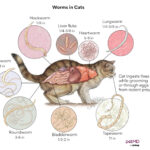“Please would you tell me…why your cat grins like that?” “It’s a Cheshire-Cat,” said the Duchess, “and that’s why…”
Introduction
The Cheshire Cat, a whimsical creation for the printed edition of Alice’s Adventures in Wonderland, has ascended to become one of the most iconic and beloved characters from Lewis Carroll’s fantastical world. Its enigmatic grin and peculiar habit of vanishing, often leaving only its smile behind, have captivated readers and viewers for generations. From the earliest silent film adaptations of Alice in Wonderland in 1903 to modern interpretations, the Cheshire Cat consistently materializes in nearly every visual and cinematic portrayal of Wonderland, solidifying its place in popular culture. This grinning feline embodies the delightfully absurd logic that permeates Wonderland, as famously demonstrated in its conversation with Alice about madness.
“And how do you know that you’re mad?” “To begin with,” said the Cat, “a dog’s not mad. You grant that?” “I suppose so,” said Alice. “Well, then,” the Cat went on, “you see a dog growls when it’s angry, and wags its tail when it’s pleased. Now I growl when I’m pleased, and wag my tail when I’m angry. Therefore I’m mad.”
Through this exchange, the Cheshire Cat showcases its talent for twisting logic, drawing conclusions from shaky premises. When Alice attempts to challenge its reasoning, the Cat deftly changes the subject, leaving Alice in a state of bewildered frustration, a common experience in her encounters within Wonderland.
However, Alice’s perception of the Cheshire Cat is not static. In a later encounter on the Queen’s croquet ground, Alice is genuinely pleased to see the reappearing feline.
“How are you getting on?” said the Cat, as soon as there was mouth enough for it to speak with….Alice put down her flamingo, and began an account of the game, feeling very glad she had someone to listen to her…”
This shifting dynamic suggests a more nuanced role for the Cheshire Cat than simply a purveyor of nonsense. Some interpretations view the Cheshire Cat as a guiding figure for Alice. It is, after all, the Cheshire Cat who directs Alice towards the chaotic Mad Tea Party at the March Hare’s house, a pivotal event that propels her further into her Wonderland journey and ultimately towards the Queen’s garden. Adding to its mystique, the Cheshire Cat possesses an almost supernatural understanding of Wonderland’s bizarre rules and landscapes. Its ability to materialize and dematerialize at will further contributes to a spirit-like aura. Perhaps most significantly, it is through the Cheshire Cat that the fundamental nature of Wonderland is revealed to Alice and the reader: it’s all utterly mad!
The Inspiration Behind the Grin
Interestingly, the enduring image of the Cheshire Cat owes much to Sir John Tenniel, the original illustrator of Alice’s Adventures in Wonderland. Tenniel reportedly drew inspiration for his iconic depiction from the British Shorthair Tabby cat breed. This breed’s naturally round face and distinctive tabby markings, particularly the striped patterns, lent themselves perfectly to the whimsical and slightly mischievous appearance of the Cheshire Cat. The breed’s characteristic facial structure even seems to hint at a perpetual, inherent grin, mirroring the Cat’s most famous feature. It is a testament to Tenniel’s artistry that subsequent illustrators across various editions of Alice in Wonderland have largely followed his lead, often echoing the British Shorthair Tabby’s features in their own interpretations of the grinning cat.
Cheshire Cat Across Media
The Cheshire Cat’s enduring popularity extends far beyond the pages of Carroll’s book. Numerous film adaptations have brought their own unique spins to the character. Disney’s animated Alice in Wonderland (1951) presents a particularly memorable Cheshire Cat, a mischievous trickster whose antics, while entertaining, often inadvertently lead Alice into trouble, blurring the lines between helpful guide and antagonist. In stark contrast, Harry Harris’s 1985 film adaptation offers a surprisingly dark portrayal of the Cheshire Cat, embodied by Telly Savalas, lending a strangely unsettling and almost predatory air to the character. Jonathan Miller’s 1966 rendition takes a different approach, depicting a Cheshire Cat that only speaks when invisible, adding a layer of philosophical realism to the fantastical elements of Wonderland. More recently, Tim Burton’s 2010 Alice in Wonderland features Stephen Fry voicing a more whimsical yet still enigmatic Cheshire Cat, further demonstrating the character’s adaptability and continued relevance in modern interpretations.
Conclusion
The Cheshire Cat remains a captivating figure in Alice in Wonderland due to its paradoxical nature. It is both a source of confusion and enlightenment for Alice, embodying the nonsensical yet strangely logical world of Wonderland. Its philosophical pronouncements, mischievous nature, and iconic grin continue to fascinate, ensuring its place as one of literature’s most memorable feline characters and a key to understanding the enduring appeal of Alice’s Adventures in Wonderland.

